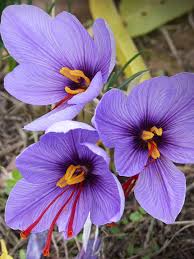
Saffron is a small perennial plant with purple or lilac coloured flowers having three stamens. The stamens are dried and used for its medicinal qualities.
Benefits of Saffron: Anaemia, cardiac congestion, angina, degenerative diseases, depression, acne, headache, hysteria, cough, cold, diarrhea, liver enlargement, asthma, bronchitis, improves skin tone, arthritis, spleen disorders.
Action: Alterative, antispasmodic, aphrodisiac, carminative, emmenagogue, rejuvenative, stimulant, stomachic.
Scientific name: Crocus sativus.
Useful part: Dried stigmas
Dosage: 100–250mg per day.
Energetics
Rasa(taste): Pungent, bitter
Vırya(energy): Hot
Vipaka(post-digestive effect): Pungent
Guna(quality): Light, unctuous
Dosa effect: VPK=, VK
Dhatu(tissue): All tissues, especially blood and reproductive
Srotas (channel): Reproductive, digestive
Dosage: 100–250mg per day.
Classical and common names
Ayurvedic: Kumkuma, Rudhira, Vadrika, Kaashmira, Kaashmiraka, Vaalhika, Agnishikhaa, Ghrusrrn, Rakta, Kshataja. Keshara.
English: Saffron, crocus